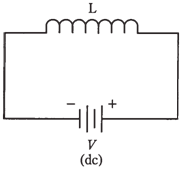Coils and direct current:
Suppose that you have some wire that conducts electricity very well. What will happen if you wind the length of the wire into a coil and connect it to a source of direct current, as shown in the Figure given to us? The wire will draw the large amount of current, blowing a fuse or over stressing a battery. It would not matter whether the wire is a single-turn loop, or whether it is lying haphazardly on floor, or whether it is wrapped around the stick. The current will be large. In amperes, it will be equal to I = E/R, here I is current, E is the direct current voltage, and R is the resistance of wire.

Figure-- A coil connected across a source of direct current.
You can make an electromagnet, as you have already seen, by passing direct current through a coil wound around an iron rod. But there will be a large, constant current in the coil. The coil will get hot, as the energy is dissipated in resistance of the wire. The battery, too, or power supply components, will become hot.
If voltage of the battery or power supply is increased, wire in the coil, iron core or not, will get hotter. Eventually, if the supply can deliver necessary current, the wire will melt.